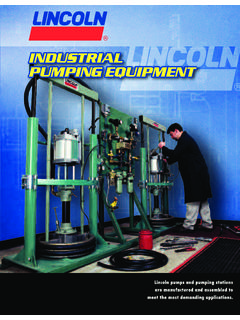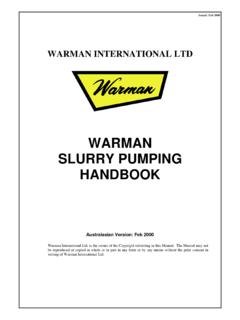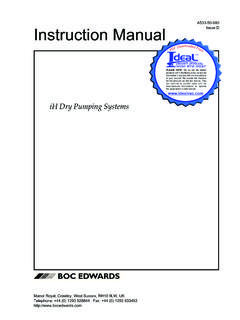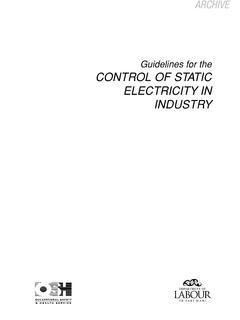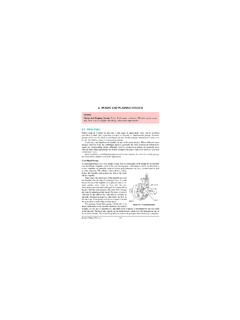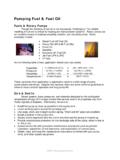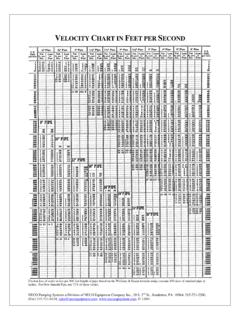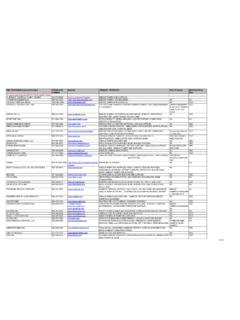Transcription of General Principles of Pumping Station Design and Layout
1 General Principles OF Pumping Station Design AND Layout Course Author: Department of the Army, Army Corps of Engineers 2 Professional Development Hours Instructor: Marc A. Broome, , Provided by: Cornerstone Education Services, LLC Box 384 Sumrall, Mississippi 39482 CECW-EEEngineer Manual1110-2-3102 Department of the Army Corps of EngineersWashington, DC 20314-1000EM 1110-2-310228 February 1995 Engineering and DesignGENERAL Principles OF PUMPINGSTATION Design AND LAYOUTD istribution Restriction StatementApproved for public release; distribution is OF THE ARMYEM Army Corps of EngineersCECW-EEWashington, DC 20314-1000 ManualNo. 1110-2-310228 February 1995 Engineering and DesignGENERAL Principles OF Pumping Station Design AND LAYOUT1.
2 Manual provides information and criteria pertinent to the Design and Layout of civil worksflood control Pumping stations. Elements discussed include various sump designs and discharge arrangements, Station type and Layout requirements, and environmental and power manual applies to all HQUSACE elements, major subordinate commands, districts,laboratories, and field operating activities having civil works THE COMMANDER:Colonel, Corps of EngineersChief of StaffThis manual combines and supersedes EM 1110-2-3101, dated 3 December 1962, and EM 1110-2-3102, dated 3 December OF THE ARMYEM Army Corps of EngineersCECW-EEWashington, DC 20314-1000 ManualNo. 1110-2-310228 February 1995 Engineering and DesignGENERAL Principles OF Pumping Station Design AND LAYOUTT able of ContentsSubjectParagraphPageSubjectParag raphPageChapter 1 IntroductionPurpose and 1-51-1 Local 1-61-2 Chapter 2 Environmental 2-12-1 Environmental 2-22-1 Environmental 2-32-1 Chapter 3 Electric Power 3-13-1 Power 3-23-1 Chapter 4 Station DesignStation 4-14-1 Station 4-24-1 Station 4-34-1 Chapter 5 equipment SelectionNumber and Size of 5-15-1 Pump 5-25-2 Chapter 6 Sump 6-16-1 Size and Capacity Determination 6-26-1 Surges in 6-36-3 Trash 6-46-4 Chapter 7 Discharge 7-17-1 Discharge Over the 7-27-1 Pressure
3 Discharge 7-37-1 Backflow 7-47-2 Outlet 7-57-2 Chapter 8 Station 8-18-1 Station 8-28-1 Trash 8-38-1 Fire 8-48-1 Heating and 8-58-1 Office 8-68-2 Appendix APlatesiEM 1110-2-310228 Feb 95 Chapter 1 Introduction1-1. Purpose and ScopeThis manual provides guidance for the Design and layoutof civil works Pumping stations used for removal ofinterior drainage from areas protected by local floodprotection works and for water discussionpresented in this manual is General in nature. The devel-opment of detailed Design criteria is presented in othermanuals referenced herein. This manual is for the guid-ance of Corps of Engineers personnel engaged in thedesign of flood protection ApplicabilityThis manual applies to all HQUSACE elements, majorsubordinate commands, districts, laboratories, and fieldoperating activities having civil works , Section 208-10, Title 1110-2-109 Hydroelectric Design 1110-2-401 Operation, Maintenance, Repair, Replacement.
4 And Rehabilitation Manual For Projects andSeparable Elements Managed by Project 1165-2-131 Local Cooperation Agreements for New StartConstruction 385-1-1 Safety and Health Requirements 1110-2-1413 Hydrologic Analysis of Interior 1110-2-1913 Design and Construction of 1110-2-3104 Structural and Architectural Design of 1110-2-3105 Mechanical and Electrical Design of Pumping 10 Standard for Portable Fire 101 Life Safety Code1-4. PlatesPlates 1 through 12 in Appendix A show different typesof Pumping stations constructed by the Corps of Engi-neers. A short description of each Pumping Station is Pumping stations are one of themore vulnerable features of a flood protection failure of a Pumping Station during a flood couldresult in considerable damage within the protected would cause the loss of some or all of the benefitsthat justified construction of the , Station dependability must be the primary consideration,during the Design and pump selection While the cost of the Pumping sta-tion is generally but a small percentage of the cost of theentire project.
5 This does not mean that the designer is toproceed without any consideration of cost. Because of theinfrequent operation of the majority of local flood protec-tion Pumping stations, efficiency can be sacrificed to acertain extent in favor of equipment with a lower , higher pump efficiencies can actuallylower the installed horsepower requirements and reduceoperating costs for large stations that have frequent extra costs to provide higher efficiency equipmentshould be studied on a life cycle cost basis over the proj-ect life. This economic study should consider both firstcost and the cost of operation, maintenance, and replace-ment of equipment over the project equipment selected must berugged, reliable, and well suited for the required type ofservice.
6 The Pumping Station structure should be sized tohouse and support the whichmake no realistic contribution to usability or dependability1 Available from National Fire Protection Association, Box 9146, Quincy, MA 1110-2-310228 Feb 95should be strictly avoided. Architectural appearance willnot be a governing criterion except in highly developedareas where concessions in regard to exterior treatmentmay be made as discussed in EM stations. In the Design of some stations anunusual combination of conditions may be encounteredwhich will require special treatment. This will frequentlybe the case for exceptionally large stations.
7 However, thefundamental Principles , criteria, and policies providedherein are applicable to all having acapacity of 30 cu m/sec (1,060 cu ft/sec) or larger will beengineered by the Hydroelectric Design Center (HDC) inaccordance with ER Local Project cooperation agreements (PCAs)are prepared by the project management office inaccordance with ER responsiblefor the preliminary Design and Layout of the pumpingfacility should coordinate any special Design features thatmay affect the local sponsor s costs with the and operation. A project s Opera-tion and maintenance manual will outline the responsibil-ities of the project sponsor for the operation, maintenance,repair, replacement, and rehabilitaion (OMRR&R) of allproject features.
8 Instructions for the preparation of opera-tion and maintenance manuals are provided in ER 1110-2-401. Development of the Pumping Station feature of themanual is contained in EM 1110-2-310228 Feb 95 Chapter 2 Environmental Requirements2-1. GeneralThe planning, Design , construction, and operation ofpumping stations should be accomplished with full con-sideration for the project s environmental of these requirements are dictated by Federal orstate statutes, by local sponsor s desires, or by USACE policy. In any case, studies of Pumping Station featuresshould be undertaken to identify potential impacts and todefine environmental objectives and Environmental ImpactsPumping stations affect the hydrology and water qualityof both the receiving and supplying water hydrologic and water quality conditions oftenaffect other environmental parameters.
9 The following listcontains some of the potential adverse environmentalimpacts of a Pumping Station dissolved turbidity and suspended habitat (riparian and aquatic). in hydrology and generated by prime mover (diesel versuselectric). fuel oil and lubricating oil and Environmental ObjectivesA Pumping Station can and should have negligible adverseenvironmental impacts. Through proper planning, Design ,construction, and operation, many of the adverse impactslisted above can be avoided or should be mitigated and environmental enhance-ment addressed. The following steps should be taken tobetter ensure satisfactory compliance with the environ-mental objectives of Pumping Station all environmental objectives and con-straints, including statutory and policy require-ments and sponsor s all potential environmental impacts, bothadverse and Design , construction, or operationfeatures that avoid or minimize adverse unavoidable adverse impacts and incor-porate appropriate mitigative environmental enhancement featuresas required to address the sponsor s desires(sponsor funded).
10 2-1EM 1110-2-310228 Feb 95 Chapter 3 Electric Power Supply3-1. the power requirements for thepumping Station have been tentatively established, theadequacy of the intended source of electric power and anylimitations of that source must be ascertained before pro-ceeding with Station Design investigationsshould disclose:(1) Maximum available power.(2) Capacities and location of existing transmissionlines, distribution lines, and substations which may beinvolved in the supply of power to the Pumping Station .(3) Voltage regulation characteristics.(4) The power company s maximum permissiblemotor in-rush current limitations and short responsibility for the supply ofelectric energy required for the operation of the pumpingstations after completion of the project rests with the extension of existing power transmissionfacilities required to make this energy available at thepumping Station site is a construction feature and theresponsibility of the Government.

